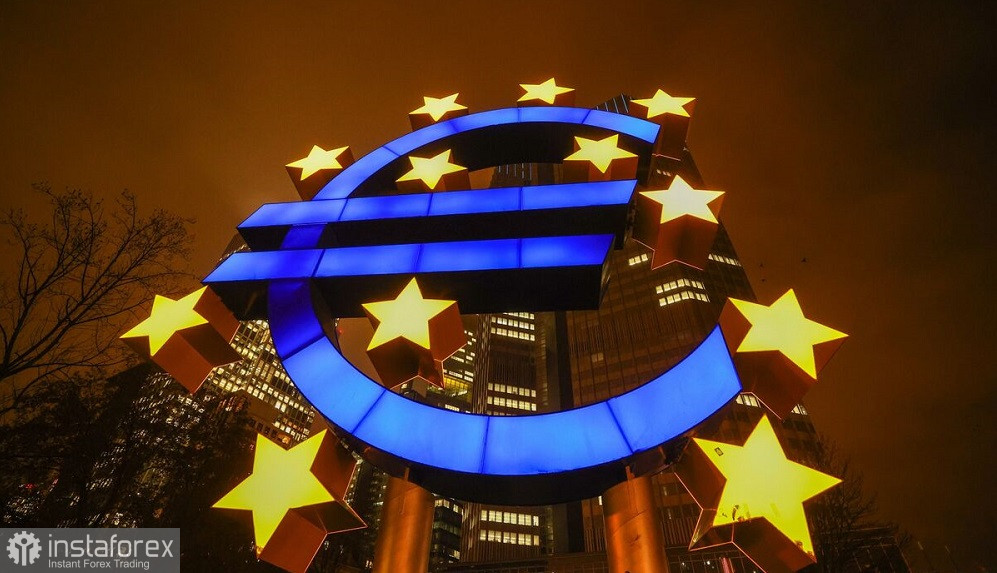Today, all eyes of traders in dollar pairs are focused on the US Federal Reserve, which will soon announce its verdict. But regardless of the Fed's decision, the EUR/USD pair will be waiting for the second piece of the puzzle: the ECB. Undoubtedly, the US regulator will provoke strong volatility in the pair—there is no doubt about that. However, regarding the medium to long-term perspectives, the position of the ECB is crucial. Only after the ECB reveals its decision will EUR/USD traders be able to determine the direction of the price movement.
According to the general forecast, the European regulator will raise interest rates by 25 basis points following the June meeting. It is also likely to announce that the asset purchase program will continue until 2024.
Usually, the implementation of the most anticipated scenario is calmly perceived by traders when there is no intrigue. In such cases, the main focus is on the further prospects of tightening monetary policy. However, in this case, it can be assumed that the euro will react with growth even to the realization of the base scenario. This is because the ECB will make a hawkish decision against the backdrop of inflation slowdown in the eurozone and technical recession.

Let's recall that the overall consumer price index declined to 6.1% in May, with a forecast decline of 6.3%. This is the slowest growth rate since March 2022. For comparison, in the previous month (April), the overall index stood at 7.0%. The core inflation rate, excluding energy and food prices, declined to 5.3% (with a forecast of growth to 5.6%). This component of the report has been declining for the second consecutive month.
Moreover, it was announced last week that the seasonally adjusted GDP in the eurozone declined by 0.1% in the first quarter of this year. This means the Eurozone economy has entered a technical recession, as the GDP volume contracted by 0.1% quarter-on-quarter in the fourth quarter of 2022. According to Eurostat representatives, the weakness of the European economy in the first quarter was due to a decrease in government and household expenditures.
Disappointing data on retail sales volume in the eurozone were also published last week. The indicator came in at 0.0% monthly, with a forecast of 0.2% growth. In annual terms, the sales volume declined by 2.6% compared to the forecasted decline of 1.8%.
As we can see, the fundamental backdrop does not support a more hawkish sentiment. Therefore, if the European Central Bank raises rates by 25 basis points and announces further steps in this direction, the euro will benefit from the unfolding situation.
And this is highly likely.
Despite the slowdown in inflation in the eurozone and the onset of a technical recession, the rhetoric of many European Central Bank (ECB) officials has noticeably hardened recently. Over the past two weeks, almost all ECB members who have spoken have stated that the central bank needs "more rate hikes" to achieve the target inflation level of two percent. Among those making corresponding statements were Lagarde, Knot, Vasle, Guindos, Muller, Villeroy, and Nagel.
It is also necessary to recall the minutes of the ECB's May meeting, which surprisingly turned out to be hawkish. The document stated that several members of the Governing Council expressed support for raising rates by 50 basis points. It also mentioned the views of "some central bank members" that more decisive action is needed to make rates sufficiently restrictive to bring inflation back to the target level.
Judging by subsequent statements from many ECB members (including after the latest inflation report in the eurozone), the central bank has maintained its hawkish stance. Therefore, it is likely that the European Central Bank will raise rates by 25 basis points tomorrow and announce further steps in that direction.
According to Japanese holding company Nomura experts, the ECB will raise rates in June and July, totaling 50 basis points. They are confident that the first rate cut will only occur after the end of 2024. Similar forecasts were voiced by economists at the largest French financial conglomerate, Societe Generale. According to them, the June and July rate hikes are decided, while further prospects will depend on the dynamics of inflation indicators.
Thus, according to the general forecasts of experts, the euro will benefit from the ECB's June meeting. Considering the previous rhetoric of ECB representatives (including Christine Lagarde), the European regulator will raise rates by at least 25 basis points and, secondly, maintain a hawkish stance regarding its future actions. Suppose the Federal Reserve maintains the status quo in June and announces a continued wait-and-see position. In that case, the policy divergence between the Fed and the ECB will narrow, thereby supporting buyers of EUR/USD.
Alternative Scenario
There is also an alternative scenario for the ECB's June meeting, in which the central bank raises rates but states that financial conditions have tightened to the extent that they may threaten economic growth (especially since the eurozone has de facto entered a technical recession). The central bank may also point out the weakening of the European Commission's economic growth forecast and express concerns about the future of the Chinese economy. Such a tone in the accompanying statement would put pressure on EUR/USD despite the actual rate increase.
However, given the previous rhetoric of many ECB officials, such a scenario appears unlikely. The European Central Bank is more likely to adopt a hawkish position regarding its future actions.
The prospects of a northward trend in EUR/USD will depend on how "hawkish" the ECB is and how "dovish" the Federal Reserve is. In any case, it is advisable to maintain a wait-and-see position until the Fed's and the ECB's verdicts on the pair are announced.
 English
English 
 Русский
Русский Bahasa Indonesia
Bahasa Indonesia Bahasa Malay
Bahasa Malay ไทย
ไทย Español
Español Deutsch
Deutsch Български
Български Français
Français Tiếng Việt
Tiếng Việt 中文
中文 বাংলা
বাংলা हिन्दी
हिन्दी Čeština
Čeština Українська
Українська Română
Română

